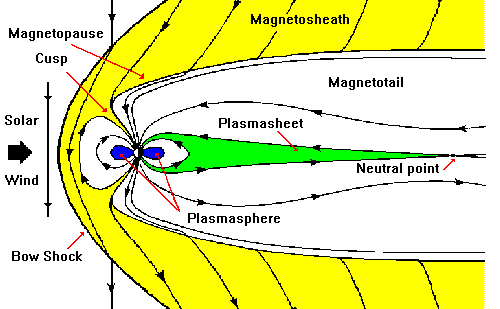 Magnetosphere
(Earth's)
Magnetosphere
(Earth's) Magnetosphere
(Earth's)
Magnetosphere
(Earth's)spaceweb@oulu.fi - last update: 29 November 1998, 1450 UT (RR)
Earth is one of the planets that has a strong internal magnetic field. In the absence of any external drivers, the geomagnetic field can be approximated by a dipole field with an axis tilted about 11 degrees from the spin axis. The forcing by the solar wind is able to modify this field, creating a cavity called the magnetosphere. This cavity shelters the surface of the planet from the high energy particles of the solar wind. The outer boundary of the magnetosphere is called the magnetopause. In front of the dayside magnetopause another boundary called the bow shock is formed because the solar wind is supersonic. The region between the bow shock and the magnetopause is called the magnetosheath. At low-altitude limit, magnetosphere ends at the ionosphere. The magnetosphere is filled with plasma that originates both from the ionosphere and the solar wind.

Solar wind and the magnetic field it carries along (IMF) modify the form of the magnetosphere, by pushing it in in the dayside and creating a long magnetotail in the nightside. As a consequence, the distance of the magnetopause from the Earth is only about 10 Earth's radii (Re=6400 km) in the dayside, while the tail is more than 10 times longer. The magnetic field in the tail points towards the Earth in the northern half and away in the southern half, this geometry being supported by a cross-tail current (neutral sheet).
The main product of the solar wind - magnetosphere coupling is the large scale magnetospheric convection electric field. In addition, the magnetospheric cavity is affected by the solar wind pressure pulses. The energy that is transported from the the solar wind into the magnetosphere creates geomagnetic activity and drives different kind of geomagnetic pulsations.
Earth's magnetosphere consists of several regions that are created by the field topology. The magnetotail is formed by tail lobes and the plasma sheet (on open polar cap and closed nightside auroral field lines, respectively). In the inner magnetosphere we have plasmasphere mapping to mid- and low-latitudes. Overlapping both plasmasphere and inner plasma sheet are radiation belts and ring current; also the geostationary orbit is around here. Regions closest to the magnetopause are called boundary layers (of which the cusp is shown in the figure).
See also
and